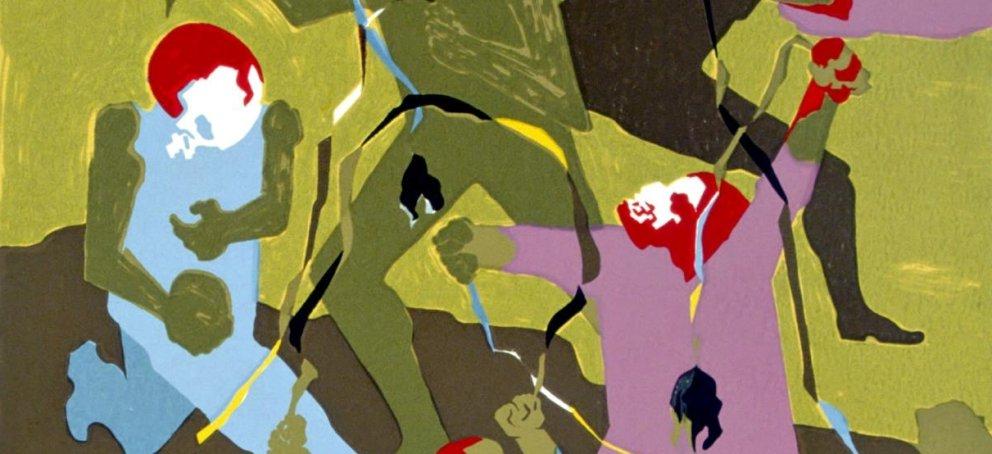JACOB LAWRENCE: THREE SERIES OF PRINTS

On view from February 15 through May 14, 2023.
Featuring work from the GENESIS, HIROSHIMA, AND 杜桑·卢维杜尔系列.
This traveling exhibition features 31 color prints created by the renowned African American artist Jacob Lawrence between the years of 1983 and 2000. The exhibition was curated by Peter Nesbett, editor of Jacob Lawrence, The Complete Prints (1963-2000), The Catalogue Raisonne, and founding director of the Jacob and Gwendolyn Lawrence Foundation.
1963年首次出版, Lawrence’s print production reflects both highly dramatic and intensely personal subjects. 在他的图形作品中, 在他的画中, Lawrence turned to the lessons of history and to his own experience. From depictions of civil rights confrontations to scenes of daily life, these images present a vision of a common struggle to-ward unity and equality, a universal struggle deeply seated in the depths of the human consciousness.
Lawrence was born in Atlantic City, 新泽西, in 1917 and passed his formative years in New York City’s Harlem neighborhood. In the mid-1930s he took art classes sponsored by the College Art Association and the WPA, at the Harlem Community Art Center and, following a two-year scholarship to the American Artists School worked in the easel division of the Federal Art Project. In 1941, Lawrence became the first African American artist included in the permanent collection of New York’s Museum of Modern Art, where he had a one-man exhibition in 1944. He lived and worked in New York City, teaching at numerous schools and universities until 1971, when he accepted a full-time faculty appointment at the University of Washington in Seattle, from which he retired as professor emeritus in 1983. Lawrence died in Seattle in 2000.
Jacob Lawrence received numerous awards and honors, including the National Medal of Arts (1990), the NAACP Annual Great Black Artists Award (1988), 斯宾加恩奖章(1970年). His work has been the subject of several major retrospectives that have traveled nationally, originating in 1986 at Seattle Art Museum, in 1974 at the Whitney Museum of American Art, and in 1960 at the Brooklyn Museum.
The works in the exhibition come from the collection of Alitash Kebede of Los Angeles, CA. Kebede was a friend and associate of Jacob Lawrence. The exhibition and national museum tour were organized by Landau Traveling 展览 of Los Angeles, CA.
广岛系列
By far one of the most graphic depictions of Lawerence’s oeuvre, the 广岛 series speaks to Lawrence’s life dedication to justice through art practice. Lawrence was invited to illustrate a book from the Limited Editions Club of New York and selected the powerful work 广岛 (1946),作者约翰·赫西. Lawrence created the illustrations focusing on events happening at the moment of the bomb's dropping on August 6, 1945. These eight scenes unfolded by capturing day-to-day life at a marketplace, 一个操场, 街景, 一个公园, 农民, 家庭场景, 有鸟的人, and a boy with a kite – no particular country, 没有特定的城市, and no particular people were depicted.
《十大网赌平台》系列
Each of the eight prints in Lawerence’s 《十大网赌平台》 series (1990) speaks to a passage from the book of 《十大网赌平台》 in the King James version. Baptized in the Abyssinian Baptist Church [in Harlem] around 1932, Lawerence grew up attending church and Sunday school. The 《十大网赌平台》 series speaks to these memories. "I remember the ministers giving very passionate sermons pertaining to the Creation. 这是五十多年前的事了, 你们知道, these things stay with you even though you don't realize what an impact these experiences are making on you at the time. As I was doing the series I think that this was in the back of my mind, hearing this minister talk about these things."
杜桑·卢维杜尔系列
Consisting of 15 prints by Jacob Lawerence, the 杜桑 Series reflects Lawrence’s chronological telling of the Haitian Revolution. Based on a series of 41 paintings completed in 1938, these silkscreen prints depict the Haitian leader in bold and robust angular forms. Born into slavery in 1743, L’Ouverture rose to become commander-in-chief of the revolutionary army. In 1800 he coordinated the effort to draw up Haiti's first democratic constitution. In 1802, L’Ouverture was arrested by Napoléon Bonaparte's troops and sent to Paris. He was imprisoned and died a year later, shortly before Haiti became the first black Western republic in 1804.